Public
Houses
Coseley once had large
mining and industrial communities, employing a
significant number of people. Most of the local
workers socialised in the many public houses
that were built to cater for them. As time
progressed, people's needs changed, particularly
when much of the industry disappeared. Today,
only a few of the pubs remain, many of the older
ones have been forgotten. The majority
disappeared as large housing estates began to
dominate the area. Most of the survivors are in
effect restaurants, that cater for the whole
family, as well as the relatively small number
of hardened drinkers.
The list below includes a
few pubs from the first half of the nineteenth
century. Coseley had a large number of pubs for
such a small place. Pubs still close because of
diminished trade, and also because they are an
ideal target for property developers. They
usually have a large car park which could
accommodate several houses.
If anyone can add to the
list or make any corrections please
send me an email. |
|
Public
Houses in Coseley |
| |
The Anchor |
Anchor Road |
|
Old Blue Bell |
Hurst
Road |
| |
Apple Tree |
Central Drive. Originally in
Castle Street, moved in 1961 |
|
The Old Bush |
Dark Lane |
| |
The
Bear |
Bayer Street |
|
The Old Bush |
Ebenezer
Street |
| |
Beehive |
Highfields Bridge |
|
The Old Bush |
Skidmore
Road |
| |
Big Cat |
Can Lane |
|
The Old
Chainyard |
Castle
Street |
| |
Bird in Hand |
Duck Street, moved to Paul Street |
|
The Old Gate |
Gorge
Road |
| |
Bird in Hand |
Male Lane |
|
Old House At
Home |
Chapel
Street |
| |
Bird in Hand |
Paul Street |
|
Old Yew Tree |
Church
Road |
| |
Black Country
Real Ale House |
Roseville Precinct, Castle St. Originally
Oscar's Wine Bar |
|
Painters Arms |
Avenue
Road |
| |
Black Horse |
Skidmore Row |
|
The Park Inn |
George
Street |
| |
Black Horse |
Upper Ettingshall Road |
|
The Prince of
Wales |
Hallfields, Daisy Bank |
| |
The Boat |
Ettingshall Road |
|
The Prince of
Wales |
York
Street |
| |
The Boat |
Havacre Lane |
|
The Prince of
Wales |
Tipton
Road |
| |
The Boat |
Highfields Road |
|
Queens Arms |
Hollywell
Street |
| |
Boot and
Slipper |
Ladymoor |
|
The Railway |
Ash
Street |
| |
Bramford Arms |
Tipton Road |
|
The Railway |
Chapel
Street |
| |
Bricklayers
Arms |
Brierley Lane |
|
The Railway
Tavern |
Meadow
Lane |
| |
Brickmakers
Arms |
Broad Lanes |
|
The Railway
Tavern |
Deepfields |
| |
British Queen |
Meadow Lane |
|
The Red Cow |
Edge
Street |
| |
British Queen |
Parkes Hall Road |
|
The Red Lion |
Daisy
Bank |
| |
The Brook |
Bourne Street |
|
The Rifle Corps |
Clifton
Street |
| |
Bulls Head |
Webb Street |
|
The Rising Sun |
Darkhouse
Lane |
| |
The Bush |
Can Lane |
|
Rollers Arms |
Foundry
Street |
| |
The Bush |
Mamble Square |
|
Rose and Crown |
Providence Place |
| |
The Bush |
Wallbrook Street |
|
The Royal |
Castle
Street |
| |
Castle House |
Bridge Street |
|
Saddlers Arms |
Darkhouse
Lane |
| |
Coseley Tavern |
Upper Ettingshall Road |
|
Ship and
Rainbow |
Rainbow
Street |
| |
Cottage Spring |
Brook Street |
|
Spread Eagle |
Birmingham New Road |
| |
Crown and
Anchor |
Deepfields |
|
Spread Eagle |
Church
Road |
| |
Deepfields Inn |
Havacre Lane |
|
Spread Eagle |
Ladymoor
Road |
| |
Druids Head |
Caddick Street |
|
Spread Eagle |
Meadow
Lane |
| |
Duke of York |
Hockley Lane |
|
Squirrel |
Lower
Bradley |
| |
Earl of Wessex |
Summerhill Road |
|
The Star |
Broad
Street |
| |
Ettingshall
Cottage |
Sodom, Ettingshall |
|
The Star |
Hurst
Hill Road |
| |
Wern Tree |
Walter Street |
|
The Summerhouse |
Can Lane |
| |
The Fountain |
Rounds Hill |
|
The Summerhouse |
School
Street |
| |
The Four Ways |
Caddick Street |
|
The Summer
House |
Sedgley
Road |
| |
The Foxyards |
Sedgley Road West |
|
The Swan |
Darkhouse
Lane |
| |
The Gate |
Ward Street |
|
The Swan |
Swan Row |
| |
Gate Hangs Well |
Hurst Road |
|
The Swan |
Sedgley
Road |
| |
Gate Hangs Well |
Pear Tree Lane |
|
The Swift
Packet |
Male Lane |
| |
Golden Lion |
Old Green |
|
The Talbot |
Bradleys
Lane |
| |
The Hillyfields |
Parkes Hall Roal |
|
Three
Horseshoes |
Ladymoor
Road |
| |
Hop and
Barleycorn |
Mason Street |
|
The Union |
Mamble
Square |
| |
Horse and
Jockey |
Ivyhouse Lane |
|
The Union |
Wallbrook
Street |
| |
Horse and
Jockey |
Robert Wynd |
|
The Union
Tavern |
Coppice |
| |
Hurst Hill
Tavern |
Caddick Street |
|
Waggon and
Horses |
Moor
Street, off Broad Lanes |
| |
The Ivy House |
Ivyhouse Lane |
|
The Wallbrook |
Chapel
Street |
| |
The King
William |
Can Lane |
|
The Wallbrook
Tavern |
Wallbrook
Street |
| |
Lord
Collingwood |
Can Lane |
|
White Horse |
Upper
Ettingshall Road |
| |
Miners Arms |
Hurst Road |
|
White House |
Daisy
Street |
| |
The Navigation |
Can Lane |
|
White Lion |
Castle
Street |
| |
The New Inn |
Broad Street |
|
The Woodcross |
Woodcross
Street |
| |
The New Inn |
Ward Street |
|
|
|
| |
The New Inn |
Regent Street |
|
|
|
|
|
Beer houses:
82, Can Lane, Hurst Hill
19, Ward Street, Mount Pleasant |
|

The Apple Tree in Castle Street. From an old postcard.
|
The Evolution of the
Traditional English Pub
The traditional English pub evolved
into several separate rooms, each with its own purpose.
The bar, with a counter, was copied from gin houses,
where the idea was to serve customers quickly, and keep
an eye on them.
The saloon bar, or lounge, appeared
in the latter part of the 18th century, as a
comfortable, carpeted, and well furnished room with an
admission fee, or higher priced drinks. It catered for
more affluent people. Often entertainment would be
provided, and drinks were served at the table.
The tap room, or public bar, was
developed for the working classes. It had simple wooden
bench seats, cheap drink, and bare floorboards, or
tiles, that were often covered in sawdust to absorb
spillages, and spit.
Another room, the snug, sometimes called the smoke
room, was a small, private room where people could drink
without being observed. The windows were made of frosted
glass, and the room had a separate entrance to the bar,
so that people could enter and leave without being seen.
There was usually access to a separate section of the
bar, where a higher price would be paid for drinks. The
snug was often used by ladies, at a time when the pub
was perceived to be for men only, and also by courting
couples, who liked their privacy.
There was often an off licence, where
beer, wine, or spirits could be purchased for home
consumption. It was a small room with a counter, or
often just an open window facing the back of the bar,
through which people were served.
Customers, including children, sent on
an errand by their parents, could take bottles to be
filled with beer. A paper seal would often be stuck over
the stopper to ensure that the children didn't sample
the contents.
Beer Houses
Many of the bubs began as beer
houses with a beer house license. Beer was considered to
be a harmless, nutritious alternative to gin, the
consumption of which should be actively encouraged. This
idea led to the Passing of the 1830 Beer House Act that
introduced new and radical changes in the law. It
allowed any householder and tax payer to obtain a
license to sell beer on their premises, in exchange for
a 2 guinea licence fee. Licensees were not allowed to
sell spirits or fortified wines. Anyone doing so would
be closed down, and heavily fined.
The legislation led to a rapid rise
in the number of public houses, and the introduction of
a new class of licensed premises, the beer house. Beer
houses were family homes, in which beer was usually sold
in the front room, and dispensed from a jug, or directly
from the barrel. Often the room was simply furnished
with bare floorboards, wooden benches, and trestle
tables. By the 1850s beer houses greatly outnumbered
pubs. Some of the early beer houses carried names, just
like pubs. Many of the more successful beer houses
eventually became pubs.
Beer houses flourished until the
introduction of the Wine and Beer House Act of 1869,
which prevented the opening of new beer houses, and
tightened local magistrates' control of the industry. By
the early years of the 20th century they had all gone. |
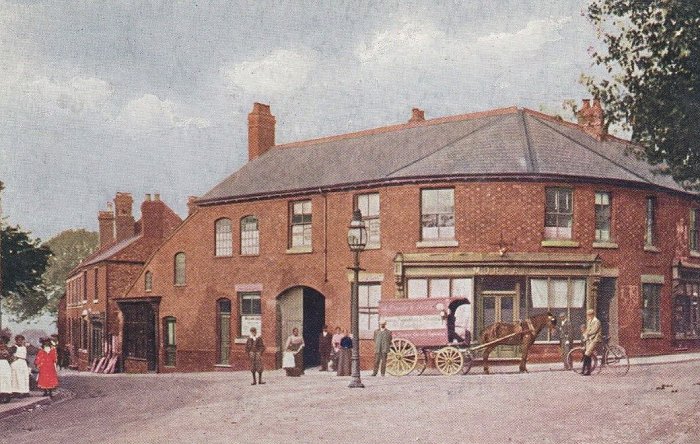
The Square, Roseville. From an old postcard.
|
Many of the older pubs, originally
had a beerhouse license. Some of the licensees,
particularly in the 19th century, had a second job.
Edward Jones, who was the owner and licensee of the
Anchor, in Anchor Road, was also a sheet iron worker and
a bucket maker. Joseph Dicken, licensee of the
Deepfields Inn, was also a brickmaker and Benjamin Webb,
licensee of the Bulls Head was a coalmaster. Another
brickmaker, Joseph Rudge, was licensee of the New Gate,
and Henry Nock, licensee of the Navigation, was a
carpenter.
Several licensees also were
shopkeepers, including Eber Stanley of the White Horse,
and
John Skidmore, of The Union. Joseph Beardmore, of the
Coseley Tavern, was a grocer, and William Harper of the
Three Horseshoes, was a butcher. Richard Caddick,
licensee of the Old Bush, was also a screw maker, as was
William Waterhouse of the Old Gate. Another licensee,
Joseph Massey, of the Woodcross, was also a blacksmith,
others were maltsters or brewers.
Some of the pubs had nicknames,
including the Brickmakers Arms, known as ‘Shutty’s’, the
Druids Head, known as ‘Flavell’s’, The Spread Eagle,
known as ‘The Ten Legs’ and the Summerhouse, known as
‘The Puzzle Garden’, because it had a maze in the
grounds. The Swan became known as ‘David Hyde’s’, the
Waggon and Horses was known locally as ‘Leggy’s’ and the
White Lion was called ‘Webbie’s’.
Pigeon racing was once a common
hobby in which participants joined a local pigeon flyer's
club, based at a local pub. A number of local pubs had
such clubs, including the Bird in Hand, in
Duck Street, the Bird in Hand in Paul Street, the New
Inn and the Woodcross. Some of the pubs competed in
local darts or crib leagues, and others had football or
cricket teams who also competed locally. Ian Stenner,
one of the licensees at the Apple Tree was also a
wrestler, who competed under the name of Pat Patton.
|
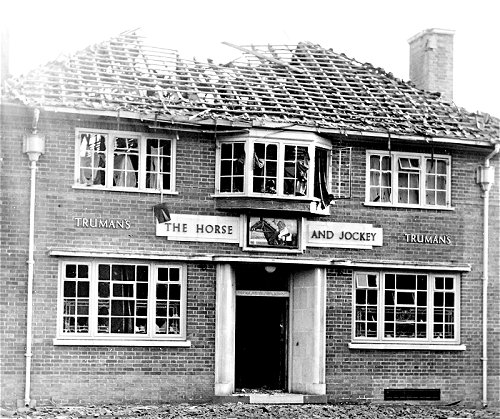 |
The Horse and Jockey in Ivyhouse Lane was hit by
a German bomb on the 30th August 1940. Around 50
people were in the building at the time, but luckily
no one was injured.
The building was later repaired but suffered from
an arson attack some years later.
After being in a derelict state for ten years or
so, it was demolished in 2021 or 2022. |
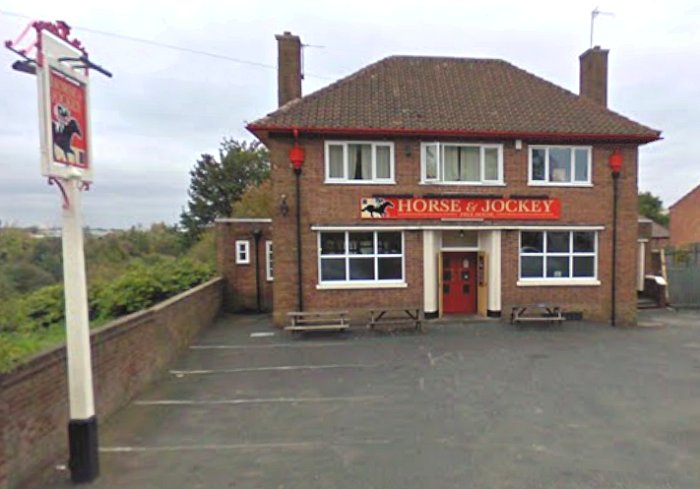
The Horse and Jockey near the end of
its working life.
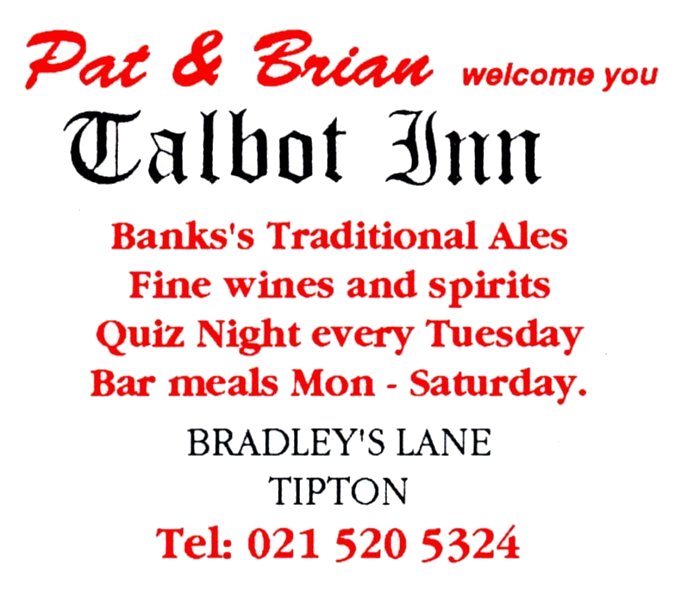
An advert from 1994.
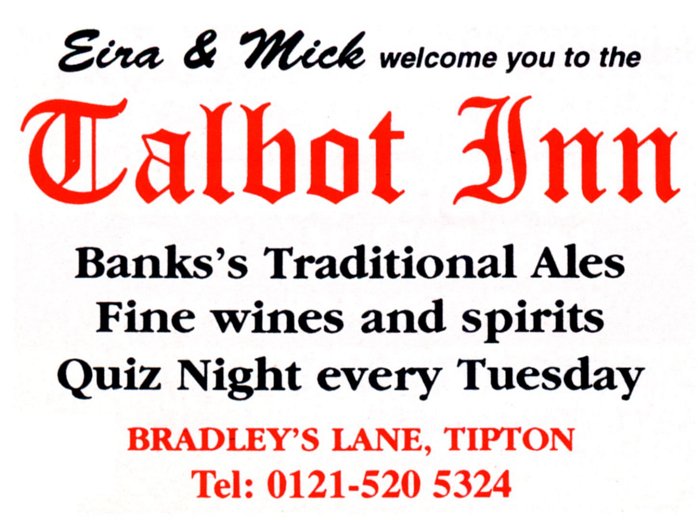
An advert from 1997. The quiz
night on Tuesday evenings, at the
Talbot, in the 1990s was always
extremely popular. The pub was often
packed-out for the event. |
|
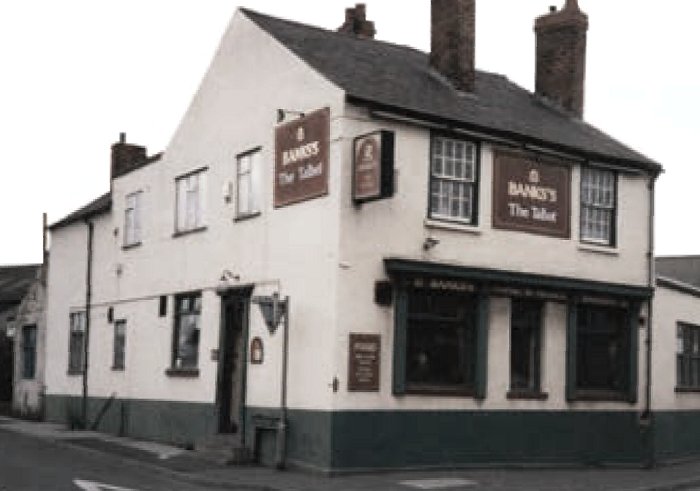
The Talbot in the
1990s. |
The Public House
Today
Sadly many pubs have disappeared
within the last few years, and still continue to do so
at an alarming rate. The pub was used mainly by working
class communities, and factory workers. Most of the
factories are now gone and working class communities
have largely disappeared. Many people now drink at home,
taking advantage of the cheap beer, wines and spirits
that can be found in the local supermarket. The smoking
ban and tougher drink-drive regulations have also had an
impact, as has the downturn in the economy.
Hitchmough's Black Country Pubs:
http://longpull.co.uk/downloads.html has been a
great help in preparing this section.
|
 |
|
 |
|
 |
Return to
Industries |
|
Return to
the
Contents |
|
Proceed to the
20th century |
|